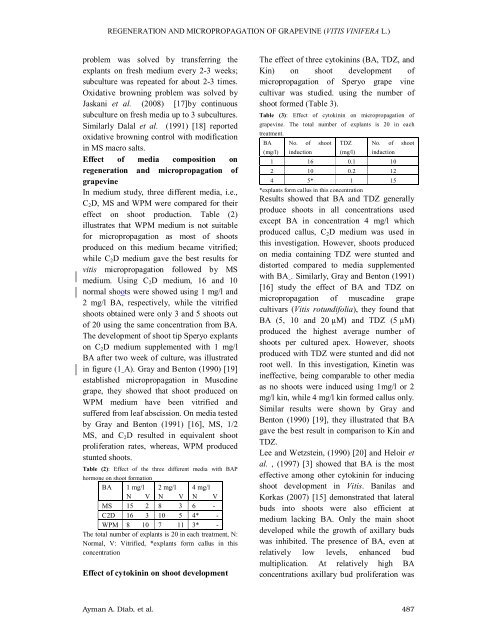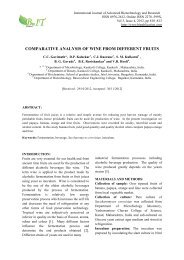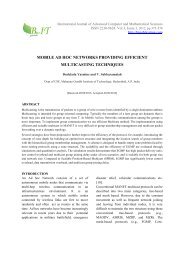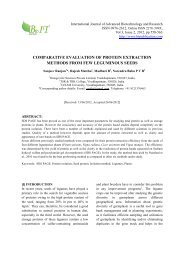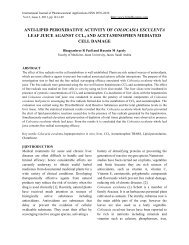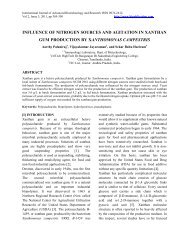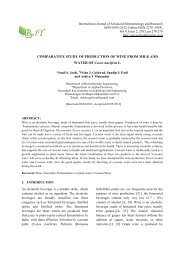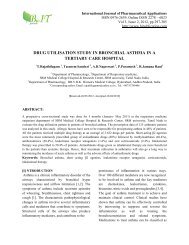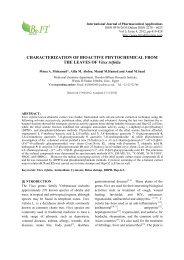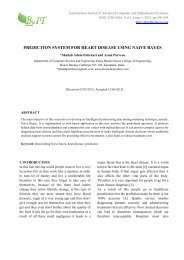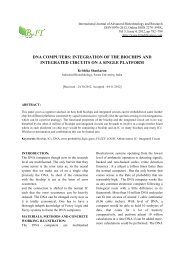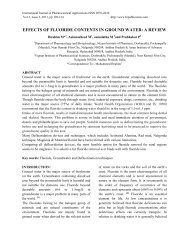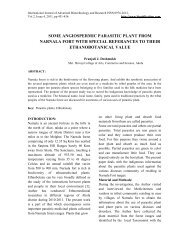regeneration and micropropagation of grapevine - BioIT ...
regeneration and micropropagation of grapevine - BioIT ...
regeneration and micropropagation of grapevine - BioIT ...
Create successful ePaper yourself
Turn your PDF publications into a flip-book with our unique Google optimized e-Paper software.
REGENERATION AND MICROPROPAGATION OF GRAPEVINE (VITIS VINIFERA L.)<br />
problem was solved by transferring the<br />
explants on fresh medium every 2-3 weeks;<br />
subculture was repeated for about 2-3 times.<br />
Oxidative browning problem was solved by<br />
Jaskani et al. (2008) [17]by continuous<br />
subculture on fresh media up to 3 subcultures.<br />
Similarly Dalal et al. (1991) [18] reported<br />
oxidative browning control with modification<br />
in MS macro salts.<br />
Effect <strong>of</strong> media composition on<br />
<strong>regeneration</strong> <strong>and</strong> <strong>micropropagation</strong> <strong>of</strong><br />
<strong>grapevine</strong><br />
In medium study, three different media, i.e.,<br />
C 2 D, MS <strong>and</strong> WPM were compared for their<br />
effect on shoot production. Table (2)<br />
illustrates that WPM medium is not suitable<br />
for <strong>micropropagation</strong> as most <strong>of</strong> shoots<br />
produced on this medium became vitrified;<br />
while C 2 D medium gave the best results for<br />
vitis <strong>micropropagation</strong> followed by MS<br />
medium. Using C 2 D medium, 16 <strong>and</strong> 10<br />
normal shoots were showed using 1 mg/l <strong>and</strong><br />
2 mg/l BA, respectively, while the vitrified<br />
shoots obtained were only 3 <strong>and</strong> 5 shoots out<br />
<strong>of</strong> 20 using the same concentration from BA.<br />
The development <strong>of</strong> shoot tip Speryo explants<br />
on C 2 D medium supplemented with 1 mg/l<br />
BA after two week <strong>of</strong> culture, was illustrated<br />
in figure (1 A). Gray <strong>and</strong> Benton (1990) [19]<br />
established <strong>micropropagation</strong> in Muscdine<br />
grape, they showed that shoot produced on<br />
WPM medium have been vitrified <strong>and</strong><br />
suffered from leaf abscission. On media tested<br />
by Gray <strong>and</strong> Benton (1991) [16], MS, 1/2<br />
MS, <strong>and</strong> C 2 D resulted in equivalent shoot<br />
proliferation rates, whereas, WPM produced<br />
stunted shoots.<br />
Table (2): Effect <strong>of</strong> the three different media with BAP<br />
hormone on shoot formation<br />
BA 1 mg/l 2 mg/l 4 mg/l<br />
N V N V N V<br />
MS 15 2 8 3 6 -<br />
C2D 16 3 10 5 4* -<br />
WPM 8 10 7 11 3* -<br />
The total number <strong>of</strong> explants is 20 in each treatment, N:<br />
Normal, V: Vitrified, *explants form callus in this<br />
concentration<br />
Effect <strong>of</strong> cytokinin on shoot development<br />
The effect <strong>of</strong> three cytokinins (BA, TDZ, <strong>and</strong><br />
Kin) on shoot development <strong>of</strong><br />
<strong>micropropagation</strong> <strong>of</strong> Speryo grape vine<br />
cultivar was studied. using the number <strong>of</strong><br />
shoot formed (Table 3).<br />
Table (3): Effect <strong>of</strong> cytokinin on <strong>micropropagation</strong> <strong>of</strong><br />
<strong>grapevine</strong>. The total number <strong>of</strong> explants is 20 in each<br />
treatment.<br />
BA<br />
(mg/l)<br />
No. <strong>of</strong> shoot<br />
induction<br />
TDZ<br />
(mg/l)<br />
No. <strong>of</strong> shoot<br />
induction<br />
1 16 0.1 10<br />
2 10 0.2 12<br />
4 5* 1 15<br />
*explants form callus in this concentration<br />
Results showed that BA <strong>and</strong> TDZ generally<br />
produce shoots in all concentrations used<br />
except BA in concentration 4 mg/l which<br />
produced callus, C 2 D medium was used in<br />
this investigation. However, shoots produced<br />
on media containing TDZ were stunted <strong>and</strong><br />
distorted compared to media supplemented<br />
with BA . Similarly, Gray <strong>and</strong> Benton (1991)<br />
[16] study the effect <strong>of</strong> BA <strong>and</strong> TDZ on<br />
<strong>micropropagation</strong> <strong>of</strong> muscadine grape<br />
cultivars (Vitis rotundifolia), they found that<br />
BA (5, 10 <strong>and</strong> 20 µM) <strong>and</strong> TDZ (5 µM)<br />
produced the highest average number <strong>of</strong><br />
shoots per cultured apex. However, shoots<br />
produced with TDZ were stunted <strong>and</strong> did not<br />
root well. In this investigation, Kinetin was<br />
ineffective, being comparable to other media<br />
as no shoots were induced using 1mg/l or 2<br />
mg/l kin, while 4 mg/l kin formed callus only.<br />
Similar results were shown by Gray <strong>and</strong><br />
Benton (1990) [19], they illustrated that BA<br />
gave the best result in comparison to Kin <strong>and</strong><br />
TDZ.<br />
Lee <strong>and</strong> Wetzstein, (1990) [20] <strong>and</strong> Heloir et<br />
al. , (1997) [3] showed that BA is the most<br />
effective among other cytokinin for inducing<br />
shoot development in Vitis. Banilas <strong>and</strong><br />
Korkas (2007) [15] demonstrated that lateral<br />
buds into shoots were also efficient at<br />
medium lacking BA. Only the main shoot<br />
developed while the growth <strong>of</strong> axillary buds<br />
was inhibited. The presence <strong>of</strong> BA, even at<br />
relatively low levels, enhanced bud<br />
multiplication. At relatively high BA<br />
concentrations axillary bud proliferation was<br />
Ayman A. Diab, et al.<br />
487


